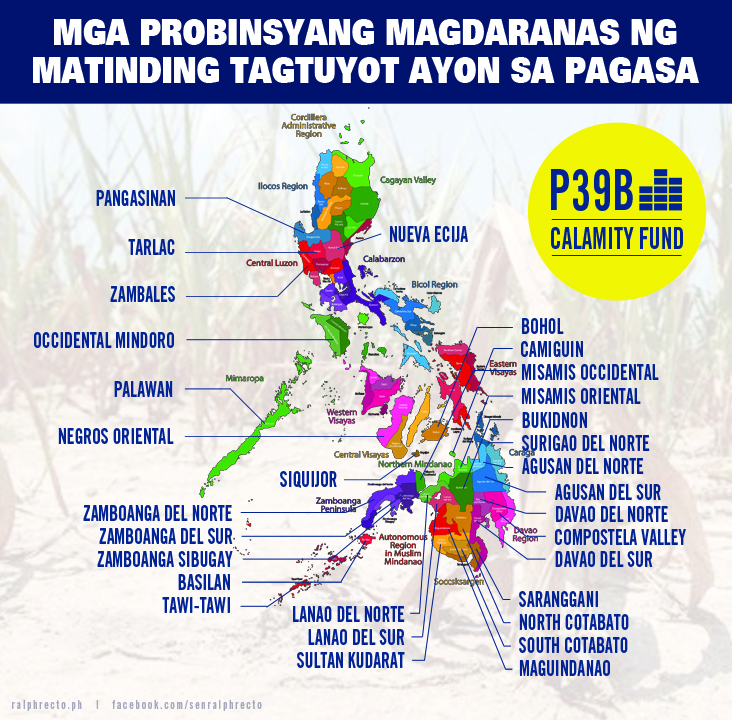Recto to Imperial Manila: Download El Niño funds now or face more Kidapawans
Senate President Pro-Tempore Ralph Recto today appealed to Malacanang to download at the soonest time possible billions of pesos in Calamity Fund and Quick Response Fund (QRF) to provinces facing the wrath of the El Niño phenomenon, saying pre-emptive measures are needed to avert a national crisis caused by widespread drought.
“The dry spell is real. Now is the time to release the funds approved by Congress to shield the country from the wrath of El Niño. Tomorrow maybe too late,” Recto said.
“We do not need to wait for the provinces to declare a state of calamity in their localities before downloading the funds. A national crisis is just around the corner,” he added.
“Dry spell plus drought of funds. That’s the formula for more Kidapawans. That should not happen because national government has the money to help local governments and farmers,” he said.
The senator again sounded the alarm bells on El Niño after the entire province of Cebu this week (April 11) joined the growing list of provinces that had declared a state of calamity due to dry spell.
Last week (April 7), the neighboring province of Bohol was also placed under a state of calamity.
Recto noted that even the Philippine Atmospheric, Geophysical and Astronomical Services Administration (PAGASA) had predicted that more than 30 provinces in the country may experience severe drought this April.
According to the weather bureau, more than 30% of the country will experience drought for three consecutive months with below normal rainfall.
PAGASA enumerated the following provinces under threat of severe drought:
- (Luzon): Pangasinan, Nueva Ecija, Tarlac, Zambales, Occidental Mindoro, and Palawan;
- (Visayas): Negros Oriental, Bohol, and Siquijor;
- (Mindanao): Zamboanga Del Norte, Zamboanga Del Sur, Zamboanga Sibugay, Bukidnon, Camiguin, Lanao Del Norte, Misamis Occidental, Misamis Oriental, Compostela Valley, Davao Del Norte, Davao Del Sur, South Cotabato, North Cotabato, Sarangani, Sultan Kudarat, Agusan Del Sur, Agusan Del Norte, Surigao Del Norte, Basilan, Maguindanao, Lanao Del Sur, and Tawi-Tawi.
“PAGASA has already identified the most vulnerable areas. They should receive the El Niño funds ASAP,” Recto said.
For this year, according to Recto, P38.9 billion has been allocated as National Disaster Risk Reduction and Management Fund in the national budget.
However, P18.9 billion of this amount is earmarked for Yolanda reconstruction, “which means only about P19 billion can be disposed for other calamities, like the El Niño.”
A lump sum fund, this Calamity Fund covers aid, relief, and rehabilitation services to areas hit by man-made and natural calamities. It also funds pre-disaster projects and operations.
The Calamity Fund, however, is separate from the P6.7 billion QRF which has been distributed among 12 agencies, with P1.32 billion given to DWSD, and P500 million each to DA and the National Irrigation Administration (NIA).
Other QRF recipients are DepEd (P1 billion); DOH (P510 million); DPWH (P1.3 billion); DOTC, including Philippine Coast Guard (P200 million); PNP (P75 million); BFP (P75 million); DND (P200 million); Office of Civil Defense (P530 million).
“As its name denotes, it’s for quick release. An emergency fund that is already prepositioned with the agencies for rapid use. Dito hindi na masalimuot ang pag-gasta. Kaya kung may QRF ang isang ahensya, walang rason na dapat maantala ang tulong,” Recto said.
The Senate leader said calamity funds and resources must end being “Manila-centric”, and one way of doing this is to deploy part of the QRF to calamity-prone regions.
Recto said Malacañang should urge local governments and national agencies to submit requests for Calamity Fund financing “to an express lane through which these will be coursed.”
“Kailangan siguro ng isang El Niño one-stop shop for calamity aid financing, one that will cut through the red tape,” he said.
He said local government units (LGUs) in El Niño -hit areas must be spared from going “through a gauntlet of agencies” when asking for aid.
Citing an official workflow, Recto said the LGUs are required “to collate voluminous documents and certifications and resolutions” in applying for national assistance.
The packet of documents is then checked by the Office of Civil Defense, which is the operating arm and secretariat of the NDRRMC.
After verification, it is sent to the Office of the President for approval.
Once approved, the request is forwarded directly to the DBM, for another round of vetting. “Then when the funds are released, there’s the complicated procurement process, then delivery.”
“Bago makabili ng damo, patay na ang kabayo,” Recto said.


